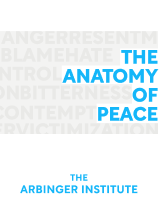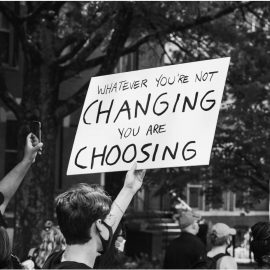

This article is an excerpt from the Shortform book guide to "The Anatomy of Peace" by The Arbinger Institute. Shortform has the world's best summaries and analyses of books you should be reading.
Like this article? Sign up for a free trial here .
What causes conflict? What is the role of cooperation in conflict resolution?
According to the Arbinger Institute, conflict arises when one or both of the parties harbor one or more of the four biases: 1) the superiority bias, 2) the entitlement bias, 3) the performative bias, and 4) the inferiority bias. Cooperative conflict resolution is only possible when both parties recognize they are biased and are willing to work through their biases.
In this article, we’ll explore how to recognize when we’re biased, how to remove that bias, and how to cultivate a cooperative mindset.
The Four Biases
- The Superiority Bias
- We justify seeing others as objects and mistreating them by telling ourselves we’re better than they are.
- We feel impatient, disdainful, or indifferent.
- Example: When you make a mess and leave it for someone else to clean up, you’re using a Superiority bias. You’re telling yourself that it’s someone else’s job to clean up after you, someone less important or valuable than you think you are.
- The Entitlement Bias
- We justify seeing others as objects and mistreating them by telling ourselves we deserve more than they do.
- We feel entitled, deprived, or resentful.
- Example: When you yell at service workers for messing up your order, you’re using an Entitlement bias. You’re telling yourself that paying money entitles you to perfect service, and that it justifies your mistreatment of the person who you think messed up.
- The Performative Bias
- We justify seeing others as objects and mistreating them by telling ourselves we need to be seen in a certain way. (Wanting others to think we’re smart, kind, cool, a good spouse or employee, and so on)
- We feel anxious/stressed, needy/fearful, or overwhelmed/overburdened.
- Example: When you pretend you know what someone’s talking about even though you have no clue, you’re using a Performative bias. You’re telling yourself that it’s more important that they think you’re smart than it is to be honest with them.
- The Inferiority Bias
- We justify seeing others as objects and mistreating them by telling ourselves we’re not good enough to do better.
- We feel helpless/despairing, bitter/jealous, or depressed/lonely.
- Example: When you refuse to interact with people you think are out of your league, you’re using an Inferiority bias. You’re telling yourself that you’re not good enough to be around them, and that justifies not putting in the effort it’d take to ensure they enjoy your company.
Address the Problem: Embody the Cooperative Mindset
Cooperative conflict resolution is only possible when both parties are willing to adopt what the Institute calls the cooperative mindset by:
- Noticing their biases.
- Willing to work through them.
- Rethinking the situation from an unbiased perspective.
- Acting on the resulting desire and sense of what they should do.
Let’s examine that in a little more detail, and try it out.
1. Notice You’re Biased
Arbinger explains that if you find yourself blaming others, justifying your behaviors, making the world or the people around you look horrible, or feeling any of the emotions associated with each of the Four Biases, you can recognize that you’re using one. This is a good time to put the principles to work.
| Why Self-Awareness Is Step One. In explaining that the first step to improving our management of conflicts is to notice our bias, Arbinger asks us to practice self-awareness—to pay attention to what we’re feeling and how we’re thinking. The core of self-awareness theory is that we are not our thoughts and feelings—rather, we are the beings that observe them. This allows us to examine ourselves, evaluate our responses, and change our patterns of thought and behavior. It enables us to feel proud of ourselves and our work, practice self-control, and see things from the perspectives of others. (On the flip-side, when we’re too critical in our self-awareness, that can lead to depression, dysfunction, and anxiety.) Self-awareness is the key to personal change because it allows us to see the gears turning in the machine whose output we wish to change. So far, we’ve noticed that something’s wrong in our approach to conflict and examined how our mindset provokes inappropriate responses to conflict. This step, and the ones that follow, rely on being self-aware from moment to moment. When we notice ourselves blaming, justifying, horrible-izing, or feeling powerfully negative, we’ll know it’s time to try the next step: to remove the bias. |
2. Remove the Bias
The Institute tells us that the first step to removing a bias is to find a space where you’re not biased at all and to take note of how it feels to be there. An unbiased space is anywhere you can be your genuine self without having to worry about how others see you or how well you’re performing. This is another key reference point. According to Arbinger, when you don’t feel this way around someone, you’ll know you’re biased against them somehow.
Finding an unbiased space can be as simple as recalling a time when you could be totally unbiased—perhaps a time you were with a person who made you feel “safe.” When you remember what it’s like to be genuine, open, and accepting toward someone, Arbinger points out, your perspective automatically shifts. Memories of brighter relationships, and calmer times in general, lift you, emotionally and mentally, out of the present moment, and they allow you to step away from the negative perspective your conflicts have trapped you in. From this more positive space, you’re able to reexamine the situation without the emotional baggage that would normally keep you biased.
Perhaps you remember a time when someone was particularly kind to you, especially when you didn’t deserve it. Maybe there’s a place in the world that triggered an open-minded perspective for you, or an activity that allows you to let it all go.
Removing your bias is remarkably easy, and that should give you hope. In the future, remember that all you really need to do to be unbiased again is to take a moment to try. The act of trying is itself a behavior that counters the combative mindset and shifts your perspective.
| Remove Your Bias by Activating the Parasympathetic Nervous System. Arbinger explains that the goal of removing our bias is to return to calm and balance so we can think and see clearly again. One way to feel calmer is to activate the parasympathetic nervous system to counteract the effects of the sympathetic nervous system. The parasympathetic and sympathetic nervous systems control most of our body’s automatic responses to stimuli. They determine how we physically feel in a conflict situation—how hotheaded we get or how cool we stay—and understanding them can be helpful in planning our conflict management strategies. The sympathetic nervous system is reactive; it responds almost instantly to dangers and threats by dialing up everything we need to fight or flee and tuning everything else down. This is very helpful when we’re physically in danger, but in a verbal conflict or a disagreement it keeps us from thinking straight, acting calmly, and making considerate decisions. The parasympathetic nervous system is responsible for calming us back down. It can be activated by touch and by the faces and voices of those we feel safe around. It works much more slowly than the sympathetic nervous system, which is why it can take us a long time to wind down after a stressful encounter—but we can activate it intentionally. One of the most powerful ways to activate the parasympathetic nervous system is to think about a safe person, someone who accepts us without judgment—something which Arbinger recommends we do above. When you find yourself caught up in feelings of anger, fear, bitterness, and so forth, pause for a moment. Imagine your safe person walking into the room, looking you in the eyes, and giving you a hug. Maybe they sit down with you and talk through your stress with you. By doing this, you activate the parasympathetic nervous system—and keep it activated until the arousing effects of the sympathetic nervous system have worn off. Once that happens, you’ll be able to think clearly and calmly again, and you’ll be ready for the next step. |
3. Rethink the Situation
As Arbinger explains, once you’ve discarded your bias, you’ll no longer see the situation from the same twisted perspective as before. You’ll be open to the possibilities your justifications had previously blinded you to; you’ll have access to new information, thoughts, and ideas. This will allow you to understand how much you’ve distorted your view, return to seeing others as people, and dismantle your justifications.
In pondering the situation anew, ask yourself:
- What’s weighing on this person I’m in conflict with, and how are their needs not being met?
- How am I contributing to that weight, and which of their needs am I ignoring?
- What have I done to hurt them, and how have I failed to help?
- What am I failing to see about the situation, about them, and about myself, as a result of the biases I’ve held? How have those biases prevented me from collaborating?
- Having considered this, what do I feel is right to do? What can I do to help, collaborate, or reach out?
| The Benefits of Perspective-Taking In this third step, the Institute asks us to take the perspective of the other party in our conflict. It’s necessary to do this because, without a realistic assessment of everyone’s needs, interests, and investment, we can’t arrive at a mutually beneficial resolution. Perspective-taking lets you see what you’re missing and choose actions that genuinely improve the circumstances of both parties. In taking the perspective of another party, keep in mind each person’s perspective…Is unique; you likely see the same situation very differently. For instance, while you might see your behavior as acceptable, the person you’re in conflict with might not. Affects what we pay attention to and what’s visible to us. We’re more likely to see how we’ve been hurt than to see how we’ve hurt others. Changes, even moment-to-moment, and depends on the situation. For instance, when you’re actively arguing with someone, they may feel deeply tied to the issue at hand. A new piece of information or a calmer moment might change that. Determines the meaning we take from the words we hear. Words and phrases you take at face value may transmit hurtful, offensive—or just different—connotations for a person who doesn’t share your background. Isn’t universal; we can’t assume others care about the same things we do. In fact, conflicts arise because even when we do care about the same things, we often care about them in different ways. When we understand how others are thinking and feeling by taking their perspective, we can…Improve our communication by changing the way we phrase and interpret messages. For example, if you know that using a certain phrase—like “we need to talk”—will aggravate the person you’re in conflict with, you can make sure to avoid using it. Accurately assess the merits of each position and determine what to prioritize. Perhaps the other person is better able to meet your needs if you address theirs first. Achieve a broader view of the issue and of each person’s emotional investment in it. It’s possible that a minor sticking point for you may be critical to the survival of the other person, and you simply hadn’t been aware of that. Improve our relationships by showing that we both see and value the needs and perspectives of others. People who care for and accommodate us are valuable—that kind of connection is worth sticking around for, and we remember their kindness. Think and act considerately, constructively, and cooperatively. Hostile conflict becomes far less common the more considerately we approach those we disagree with. Why go to war when you want peace? |
4. Act According to Your Conscience
Once you’ve removed your bias, the Institute says: Act on what you discover, and do what you’re feeling you should do. Taking the perspective of the other party in a conflict and giving genuine consideration to their weights and needs is eye-opening. What felt appropriate before, from your one-sided, self-focused perspective may no longer make sense. Instead, your conscience will prompt you with a new sense of what’s right—one that takes both perspectives into account. Don’t betray this new sense; make the effort to see everyone as people, and act according to your conscience.
According to Arbinger, staying unbiased is key to resolving and preventing conflict. It’s easy to fall back into the habit of justifying and end up biased again. But if you find yourself stuck, remember that all you need to do is remove the bias. Be curious about what you were missing, and make an effort to learn what other people are going through and how you can help.
| What Is Conscience, and How Trustworthy Is It? The Institute’s suggested method for determining what’s “right” to do in situations of conflict relies, essentially, on gathering information and evaluating it conscientiously. In short, the method primes our conscience with humanizing information about those with whom we’re in conflict and assumes we’ll choose kinder, more considerate behaviors as a result. Arbinger doesn’t explain why our conscience can be trusted to drive us toward more cooperative behavior, so let’s examine that here. Conscience, the Stanford Encyclopedia of Philosophy explains, is a self-assessment mechanism that provides motivation to act according to external or internal moral knowledge. While conscience appears to have access to moral knowledge, in that its conclusions seem to be based on our deeply-held beliefs, its judgments are conveyed to us purely through feeling—for instance, feeling that something is right or wrong. We can’t assess the validity of those feelings directly or see the reasoning process that leads to them. It could be argued, then, that the trustworthiness of conscience feelings depends primarily on the source and validity of the “moral knowledge” they’re based on. Today, the common belief is that our moral sense is determined by our upbringing and social environment. In other words, we’re taught what’s right and wrong, and we eventually develop the capacity to critically evaluate those lessons and discard or adjust them. This ability to learn, critique, and adjust is key: We may be taught, for instance, that it’s morally correct to be racist, in which case our conscience would drive us toward racist behavior. If we later evaluate that and change our beliefs, our moral “sense” will adjust to that change and judge us accordingly, driving us in a new direction. In other words, the conscience doesn’t drive us toward universally, morally “correct” behavior—just toward what we believe is right. The key to a trustworthy conscience, then, is to make sure that our deeply-held beliefs are genuinely worth acting in support of—and when it comes to conflict, that they’re conducive to collaborative behavior. The Institute asks us to accept—and hold deeply—the belief that others deserve to be seen as humans. It asks us to recognize that others have challenges, burdens, and pains—and, critically, that the needs of others should be attended to, respected, and accommodated. This belief then informs the judgments of our conscience and makes those judgments worth trusting. |

———End of Preview———
Like what you just read? Read the rest of the world's best book summary and analysis of The Arbinger Institute's "The Anatomy of Peace" at Shortform .
Here's what you'll find in our full The Anatomy of Peace summary :
- How we perpetuate conflict by misunderstanding its cause and acting inappropriately as a result
- What causes conflict, how we make it worse, and how we invite mistreatment
- The steps we can take to escape the combative mindset and set aside our biases






